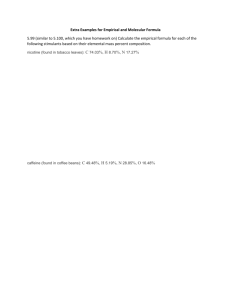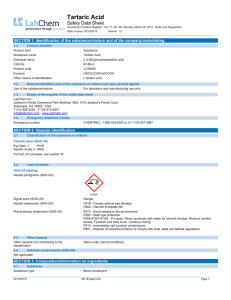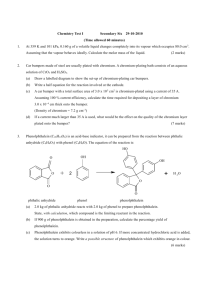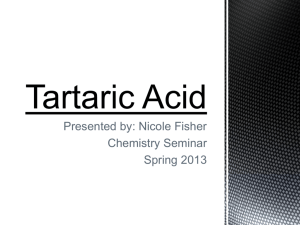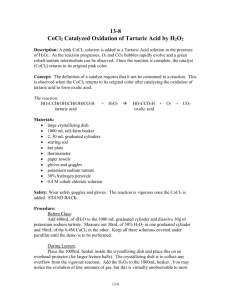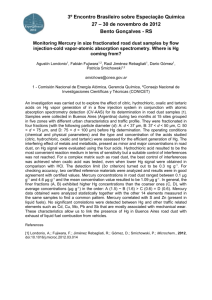Wine Acid-base Chemistry
advertisement
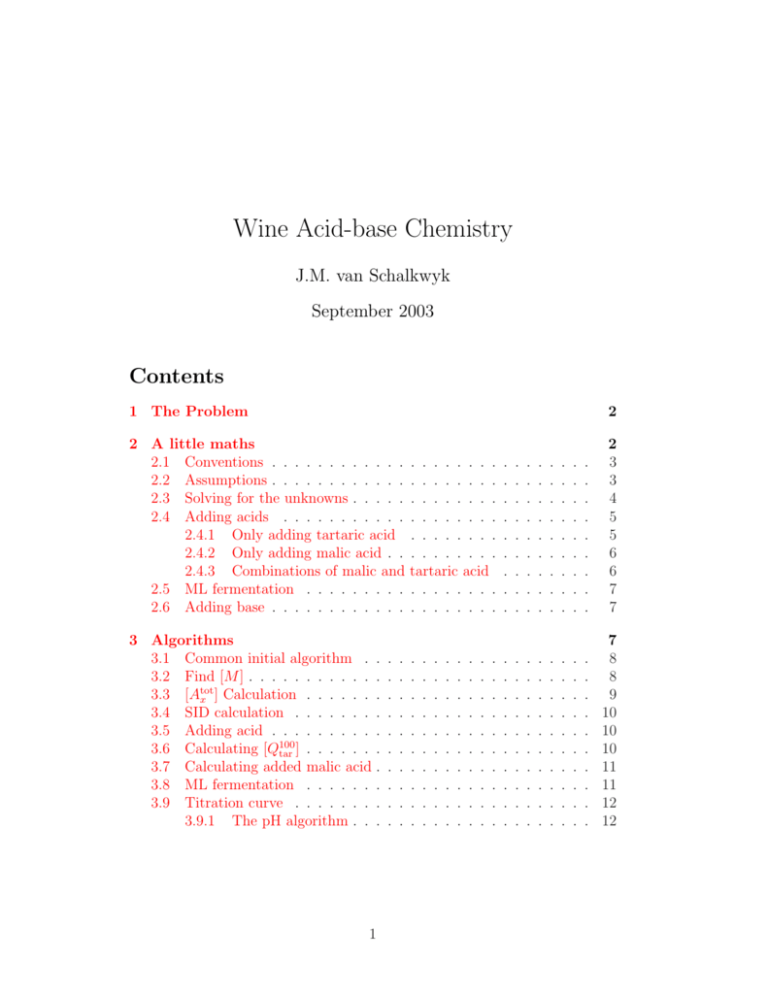
Wine Acid-base Chemistry
J.M. van Schalkwyk
September 2003
Contents
1 The Problem
2
2 A little maths
2.1 Conventions . . . . . . . . . . . .
2.2 Assumptions . . . . . . . . . . . .
2.3 Solving for the unknowns . . . . .
2.4 Adding acids . . . . . . . . . . .
2.4.1 Only adding tartaric acid
2.4.2 Only adding malic acid . .
2.4.3 Combinations of malic and
2.5 ML fermentation . . . . . . . . .
2.6 Adding base . . . . . . . . . . . .
.
.
.
.
.
.
.
.
.
2
3
3
4
5
5
6
6
7
7
.
.
.
.
.
.
.
.
.
.
7
8
8
9
10
10
10
11
11
12
12
3 Algorithms
3.1 Common initial algorithm . .
3.2 Find [M ] . . . . . . . . . . . .
3.3 [Atot
x ] Calculation . . . . . . .
3.4 SID calculation . . . . . . . .
3.5 Adding acid . . . . . . . . . .
3.6 Calculating [Q100
tar ] . . . . . . .
3.7 Calculating added malic acid .
3.8 ML fermentation . . . . . . .
3.9 Titration curve . . . . . . . .
3.9.1 The pH algorithm . . .
1
.
.
.
.
.
.
.
.
.
.
.
.
.
.
.
.
.
.
.
.
. . . . . . . .
. . . . . . . .
. . . . . . . .
. . . . . . . .
. . . . . . . .
. . . . . . . .
tartaric acid
. . . . . . . .
. . . . . . . .
.
.
.
.
.
.
.
.
.
.
.
.
.
.
.
.
.
.
.
.
.
.
.
.
.
.
.
.
.
.
.
.
.
.
.
.
.
.
.
.
.
.
.
.
.
.
.
.
.
.
.
.
.
.
.
.
.
.
.
.
.
.
.
.
.
.
.
.
.
.
.
.
.
.
.
.
.
.
.
.
.
.
.
.
.
.
.
.
.
.
.
.
.
.
.
.
.
.
.
.
.
.
.
.
.
.
.
.
.
.
.
.
.
.
.
.
.
.
.
.
.
.
.
.
.
.
.
.
.
.
.
.
.
.
.
.
.
.
.
.
.
.
.
.
.
.
.
.
.
.
.
.
.
.
.
.
.
.
.
.
.
.
.
.
.
.
.
.
.
.
.
.
.
.
.
.
.
.
.
.
.
.
.
.
.
.
.
.
.
.
.
.
.
.
.
.
.
.
.
.
.
.
.
.
.
.
.
.
.
.
.
.
.
1 THE PROBLEM
4 Java applet
4.1 User interface . . . . . . . .
4.1.1 Checks . . . . . . . .
4.1.2 Anticipated errors . .
4.2 Java code for user interface .
4.3 HTML code . . . . . . . . .
4.4 Questions . . . . . . . . . .
5 Disclaimer and GPL
1
2
.
.
.
.
.
.
.
.
.
.
.
.
.
.
.
.
.
.
.
.
.
.
.
.
.
.
.
.
.
.
.
.
.
.
.
.
.
.
.
.
.
.
.
.
.
.
.
.
.
.
.
.
.
.
.
.
.
.
.
.
.
.
.
.
.
.
.
.
.
.
.
.
.
.
.
.
.
.
.
.
.
.
.
.
.
.
.
.
.
.
.
.
.
.
.
.
.
.
.
.
.
.
.
.
.
.
.
.
.
.
.
.
.
.
13
13
14
14
15
15
15
15
The Problem
We have elsewhere discussed the reason for the creation of this Java applet,
and the associated documentation. Here we explore the mathematical basis
for the applet, and some implementation details.
2
A little maths
Consider a kilogram of wine, with certain ‘known’ values (independent variables):
1. The initial and final pH;1
2. The titratable acidity, TA of the wine, espressed as grams/kg of tartaric
acid;
3. Assumed initial ratios of each of the five acids (malic, citric, succinic,
lactic and acetic acid), to tartaric acid;
4. The equilibrium constants at 25 o C for the various equations of dissociation of the acids.
From the above, we wish to determine ‘unknowns’, including the concentrations of the various acids, and the concentrations of their various ionic
species.
1
Here, these are knowns, and not to be determined, as was the case in our exploration
of the Stewart approach to acid-base in human plasma.
2 A LITTLE MATHS
2.1
3
Conventions
Here’s our list of notational conventions. Some of them are a little arbitrary,
but they work for us!
1. We will abbreviate the six acids listed above as ‘tar’ and ‘mal, cit,
suc, lac, ace’.We will refer to an acid as Ax , x={tar, mal, cit, suc, lac,
ace}, or x = 0. . . 5, and the concentration of a particular ionic species
of such an acid as [A−i
x ], where i is the ionisation state of the acid,
i = 0. . . max(x), and max(x) in turn is the maximum ionisation state
of the acid x.2
2. We will abbreviate the total concentration of a particular acid to [Atot
x ].
3. We will represent the dissociation constants of the acids as Kxi , where x
refers to the relevant acid and i is the ionisation state in the equation:3
−(i+1)
* +
A−i
x ) H + Ax
4. We will call the ratio of the molal concentration of a particular acid x
to the molal concentration of tartaric acid ‘Cx ’.
2.2
Assumptions
We will use the following simplistic assumptions:
1. We will ignore the effects of the alcohol present on the permittivity of
the solution, and on the activity coefficient of hydrogen ions and other
ions;
2. We will conveniently (and very simplistically) ignore the ‘common ion
effect’ and the non-unity activity coefficients of the various species of
ion;
3. We will assume that at no stage is the solubility coefficient of any
pair of ionic species exceeded, causing precipitation of e.g. potassium
bitartrate!
4. We will assume that commonly available values for the various dissociation constants are accurate, apply at 25 o C, and make no comment
about whether their determination involved correction for activity coefficients, etc.
2
Note that [A0x ] is the concentration of unionised acid in solution.
Note that Kx0 will be our rather peculiar representation of the more usual dissociation
constant K1 for that acid.
3
2 A LITTLE MATHS
4
5. Finally, we assume that the PCO2 of the wine is negligible (Clearly an
inappropriate assumption for sparkling wines)!
2.3
Solving for the unknowns
Our general approach will be:
1. Convert the TA (as grams of tartaric acid per kg of wine) to a molal
amount of ‘acid titration’ — we will refer to this amount as [M ].
2. Note that:
[M ] = [H + ] +
5
X
max(x)−1
x=0
X
(max(x) − i).[Ai−
x ]
(1)
i=0
This equation is a little tricky. We wish to titrate in a strong base
(NaOH) until all acid species have been neutralised. Once titrated,
‘all’ of the currently undissociated or partially dissociated organic acid
molecules in solution will be maximally negatively charged and have
corresponding sodium ion(s) to balance this charge. There is a catch:
some of the current negative charges are counter-balanced by hydrogen
ions, which will almost completely disappear after full titration, to be
replaced by sodium ions. So we add in the concentration of hydrogen
ion!
An alternative way of expressing [M] is:
[M ] ≈
5
X
max(x)[Atot
x ] − SID
(2)
x=0
3. We know that, for any equilibrium:
Kxi =
[H + ].[A−(i+1)
]
x
[Ax−i ]
(3)
We can therefore express [Aix ] for i > 0, in terms of [A0x ], [H + ] and Kxi .
4. For each acid, by definition,
max(x)
[Atot
x ]
=
X
[A−i
x ]
(4)
i=0
This simply says that the total amount of the acid per kilogram of
wine is the sum of the molal concentrations of the various ionic species
(including the concentration of unionised acid).
2 A LITTLE MATHS
5
5. For each acid, again by definition:
tot
[Atot
x ] = Cx .[Atar ]
(5)
We use the above equations to calculate our unknowns. From (3) we can
+
i
0
express the concentration of any A−i
x , i > 0 in terms of [H ], Kx and Ax .
tot
Similarly, we can use (4) to express any ionic species in terms of [Ax ] and
various knowns. We can then in turn use (5) to express any ionic species
tot
in terms of knowns, and [Atar
]. Finally, we substitute for the various ionic
species in (1), replacing each species in turn by a value expressed as a function
of various K, C, [H + ] and [Atot
tar ]. We now have a single equation with just one
unknown, [Atot
],
so
we
can
calculate
this last value, and use it to calculate
tar
the concentration of all other species.
2.4
Adding acids
We next consider the case where the desired pH is lower than the initial pH.
We achieve this new pH by adding either tartaric acid, malic acid, or both.
From the above calculations, we know the initial concentrations of each acid,
[Atot
x ]. We also know the desired, final pH, so all we need to calculate is:
1. The amount of tartaric acid that we would need to add to achieve the
desired pH, without addition of any other acid. Let’s call the increase
in molal concentration corresponding to this amount [Q100
tar ].
2. The amount of malic acid required to achieve the same pH, on its own;
3. For each amount of tartaric acid added, in steps of, say, 1% from no
added tartaric acid up to [Q100
tar ], how much malic acid we would have
to add!
2.4.1
Only adding tartaric acid
We will adopt the convention that new, unknown concentrations (after the
addition of acids, with a corresponding change in pH) are referred to with a
prime symbol, thus: [Ax ]0 . In the first instance, how do we calculate [Q100
tar ]?
tot 0
Well, we know that our new total concentration of tartaric acid, [Atar ] is the
4
sum of the old concentration and [Q100
tar ]:
100
0
tot
[Atot
tar ] = [Atar ] + [Qtar ]
4
(6)
Well, technically not entirely correct, as we have changed the total mass of the solution
by adding mass, but the alteration is fairly small, and we will simplistically neglect it!
2 A LITTLE MATHS
6
We can use (3) to express any of the new concentrations of tartaric acid
species in terms of the various constants, and [A0tar ]0 . We can then use (4) to
0
express [A0tar ]0 in terms of [Atot
tar ] .
We also know from considerations of charge balance, that
+
[H ] + [SID] =
5
X
x=0
max(x)
X
i.[Ai−
x ]
+ [OH − ]
(7)
i=1
In other words, the sums of the concentrations of positive ions equals that
of the concentrations of negative ions multiplied by the charges of each of
these ion species. [SID] is of course the Strong Ion Difference, and in the
case of wine will be predominantly made up of calcium and potassium ions.
At a pH about 4, we can neglect [OH − ].
The SID will not change, with the added tartaric acid, and the concentrations of all of the ionic species apart from tartaric acid can be calculated,
as we know the total amounts of these acids, and, knowing the pH, can work
out the concentrations of the other species. All we don’t know in the above
equation is the new concentrations of the various species of tartaric acid. We
0
can express these in terms of [Atot
tar ] , as above.
0
We now can calculate [Atot
tar ] , and thence derive all unknowns.
2.4.2
Only adding malic acid
We can use an analogous argument to calculate the amount of malic acid
required. Determine concentrations of all of the ionic species for the new pH,
0
express all the malic species in terms of [Atot
mal ] , substitute into (7), and we’re
away!
2.4.3
Combinations of malic and tartaric acid
We will consider various concentrations of tartaric between ‘no added tar1
99
taric acid’ and [Q100
tar ]. We will refer to these as [Qtar ] . . . [Qtar ], the idea being
that we will increase the amount of tartaric in 1% increments, and then calculate the required amount of malic acid. This calculation will be relatively
straightforward, as we have already calculated [Q100
tar ]. We can now vary the
amount of tartaric acid added, as a percentage of [Q100
tar ], and calculate the
various ionic species for all acids apart from malic acid. We can then substitute these into (7), and use the above logic (Section 2.4.2) to calculate the
amount of malic acid required.
3 ALGORITHMS
2.5
7
ML fermentation
Here, we will stochiometrically convert malic acid to lactic acid, to try and
raise the pH to a target level. There are three possibilities:
1. Complete ML fermentation will be insufficient to achieve the desired
pH change;
2. Complete ML fermentation is not required, as partial fermentation will
be sufficient to raise the pH to the desired point;
3. Rarely, complete ML fermentation will achieve precisely the desired
pH.
We will put ML fermentation and addition of base (potassium carbonate)
onto the same convenient graph, plotting amount of K2 CO3 added against
amount of ML fermentation, up to the maximum amount of ML fermentation
required to achieve the desired pH.
2.6
Adding base
Here we have a well-defined question — “How much base do we have to
add to raise the pH by a certain amount?” What we are effectively doing
by adding a base (be it sodium hydroxide or potassium carbonate) is adding
positive ions, and thus increasing the strong ion difference.
Rather than simply providing a single number, we will perform the whole
titration up to a pH of ∼ 8.2.5
We will provide a graph of ‘amount of added NaOH’ against pH. The
calculation will involve progressively altering the SID from the initial value
we calculate, and then determining pH for every alteration.
In a manner similar to our initial Stewart work, we can take (7) and
substitute in various values for the SID. We then solve for pH, and we’re
away!
3
Algorithms
In this section we will create detailed algorithms for our acid-base calculator.
From the above, we can see that we require three algorithms, related to
adding malic and/or tartaric acid to achieve a lower pH, ML fermentation,
5
This might provide a ‘reality check’ of our equations and solutions, as any winemaker
can simply titrate a wine sample with NaOH, measure the pH change as the base is titrated
in, and check the titration graph against ours, possibly revealing the deficiencies in our
model!
3 ALGORITHMS
8
and titration against base. We will consider each in turn, but note that for
each, there is a common initial algorithm, and that this in turn depends on
several other algorithms. Here goes!
3.1
Common initial algorithm
1. Initialise all constant values — the various Kxi , as well as an array of
max(x) for the six acids.
2. Read in the initial pH, the initial TA, and the (molal) ratios of the
acids with respect to tartaric acid, i.e. an array of five values of Cx .
3. Calculate [M ], as described in Section 3.2.
4. Calculate the values of [Atot
x ] for each acid, using the algorithm below
(Section 3.3).
5. Calculate the SID, as below (Section 3.4).
3.2
Find [M ]
How exactly is TA determined by wine-makers? They add NaOH, and then
express the added amount in terms of tartaric acid (g/kg),6 as if they were
adding it to pure tartaric acid solution!
The conversion is straightforward, once you realise that for every mmol
of added tartaric acid, once titration has been completed, there will be two
mmol of sodium ion, forming bisodium tartrate. The molal quantity of tartaric acid is simply the number of mols of sodium hydroxide added, divided
by two.7
So, to ‘reverse engineer’ the amount of NaOH added, simply divide the
TA by the molecular weight of tartaric acid (150.09) and multiply by two.
A false argument would be to try and calculate [M] as:
∗
[M ] = 2.[A0tar ]∗ + [A−
tar ]
. . . as this incorrect equation fails to take into account the substantial
number of hydrogen ions which are paired with A2− and A− ions, and will
disappear at higher pH, to be replaced by sodium ions!
6
7
Or is it g/l, in which case we must convert?
Hmm. look at the small matter of added volume/mass, esp at 25o C.
3 ALGORITHMS
3.3
9
[Atot
x ] Calculation
0
+
0
1. For each acid x, express [A−
x ] in terms of Kx , [H ] and [Ax ], using (3).
In other words:
[A−
x]
Kx0 [A0x ]
=
[H + ]
2. Where appropriate, repeat this process for [A2−
x ], and so on:
[A2−
x ] =
Kx1 [A1−
x ]
[H + ]
[A3−
x ] =
Kx2 [A2−
x ]
+
[H ]
3. We now have concentrations of each ionic species of Ax in terms of [A0x ];
+
i
0
4. Use (4) to relate [Atot
x ] and [H ], the various Kx , and [Ax ]:
[A0x ] =
1+
[A1−
x ] =
[A2−
x ] =
Kx0
[H + ]
[Atot
x ]
1+
Kx1
(1
[H + ]
´
+
Kx2
)
[H + ]
+
Kx2
)
[H + ]
[Atot
x ]
[H + ]
Kx0
[H + ]
+1+
³
Kx1
[A3−
x ] =
³
[H + ]
Kx2
³
Kx1
(1
[H + ]
[Atot
x ]
[H + ]
Kx0
[H + ]
Kx1
³
´
+1 +1+
[Atot
x ]
[H + ]
Kx0
´
Kx2
[H + ]
´
+1 +1 +1
5. Use (5) and the above to express each species of each acid in terms of
[Atot
tar ].
[A0x ] = ³
1+
Kx0
[H + ]
³
Cx .[Atot
tar ]
1+
Kx1
(1
[H + ]
+
´´
Kx2
)
[H + ]
(8)
3 ALGORITHMS
10
. . . and so on!
Let us abbreviate the above to:
[Ai−
x ] =
Cx .[Atot
tar ]
i−
θx
(9)
Note that θ is a function of [H + ], and that we say θxi− rather than
θ([H + ], i, x) for reasons of clarity.
6. Substitute the values from the preceding step into (1) to relate [M ] and
tot
[Atot
tar ]. We can calculate [Atar ], knowing that:
[M ] = [H + ] + [Atot
tar ].
5
X
x=0
Cx .
max(x)−1
X
i=0
max(x) − i
θxi−
(10)
tot
7. Use the value of [Atot
tar ] thus derived to calculate each [Ax ].
3.4
SID calculation
1. Use the values from above (Section 3.3) and (3) to determine the concentrations of each ionic species;
2. Substitute these, and [H + ], into (7), to determine SID.
3.5
Adding acid
1. Read in the desired pH.
2. Calculate [Q100
tar ] needed to achieve this pH, as explained below in section
3.6. Store this value.
3. For 1% increments from zero to [Q100
tar ], calculate the amount of malic
acid that must be added. Do so by introducing a percentage of [Q100
tar ]
calculated above, and using a procedure analogous to section 3.6, but
0
with [Atot
mal ] as the unknown. Store the values of malic acid required to
be added in a 100 element array.
3.6
Calculating [Q100
tar ]
1. For the new pH, calculate [H + ].
2. For each acid x, apart from tartaric, use our knowledge of [Atot
x ] and
the equations from Section 3.3 to determine the concentrations of each
ionic species at the new pH.
3 ALGORITHMS
11
3. Substitute the values for the various concentrations of acid species into
(7). Note that from this equation we derive:
[H + ] + [SID] =
5
X
max(x)
x=1
X
i.[Ai−
x ] +
i=1
2
X
i.[Ai−
0 ]
i=1
or, substituting (9) into the above:
+
[H ] + [SID] =
5
X
x=1
max(x)
X
i.[Ai−
x ]
+
0
C0 .[Atot
tar ]
2
X
i
i=1
i=1
θ0i−
0
4. Solve for [Atot
tar ] :
0
[Atot
tar ] =
3.7
[H + ] + [SID] −
P5
P2
³P
x=1
max(x)
i=1
i
i=1 θi−
0
´
i.[Ai−
x ]
(11)
Calculating added malic acid
We know the total amount of tartaric acid required to lower the pH to the
desired value. We can divide the amount we need to add into, say, 100
convenient fractions, and then, for each fraction, calculate the corresponding
amount of malic acid, thus:
1. For ‘Q1 ’ (Add just 1% of the total amount of tartaric acid), determine
concentrations of the various species of tartaric acid at the desired pH.
2. In a manner analogous to the above, determine the amount of malic
acid we need to achieve the desired final pH. Store this amount of malic
acid in an array;
3. Repeat for all other fractions of tartaric acid.
3.8
ML fermentation
1. For a conversion of (say) 1% of the malic acid into lactic acid, recalculate the concentrations of all acid species at the target pH. Substitute
all of these values into (7) to determine the new SID. The difference
between the former SID and the new SID represents the molal quantity of positive (potassium) ions we still need to add to raise the pH
after the given quantity of ML fermentation has been achieved. If the
value is zero, we need add no more K2 CO3 , and if negative, then ML
fermentation has more than achieved our pH goal!
3 ALGORITHMS
12
2. Repeat the calculation for increasing amounts of ML fermentation, until
we reach our end-point pH without having to alter the SID, or 100%
ML fermentation has been achieved.
3.9
Titration curve
1. To change the pH to 8.2, we know that the amount of base required is
simply [M ], from section 2.3.
2. Divide [M ] into, say, 100 equal increments, and calculate the pH for
each increment in SID. Use the algorithm outlined below (3.9.1) to
determine pH for the various SIDs. Store the pH values in an array.
3.9.1
The pH algorithm
We wish, for example, to calculate the pH that results when we alter the SID
by a certain amount. We’ll call our starting pH pHi .
Rearranging (7) we obtain:
[H + ] + [SID] −
5
X
x=0
max(x)
X
−
i.[Ai−
x ] − [OH ] = 0
i=1
In a manner analogous to our Stewart tutorial, we can make two guesses,
an upper and lower one. Let’s play it safe and set the following limits to
our guesses. Our lower limit will be the initial pH, pHi and our upper limit,
pHtop , will simply be 8.2. Our first guess will be the geometric mean of the
q
two ( pHi .pHtop ).
In order to calculate [OH − ] (which becomes significant at a pH of above
7), we note that:
[H + ] ∗ [OH − ] = Kw0
. . . where Kw0 is the dissociation constant for water multiplied by the molal
concentration of water. At 25o C the value for water is 1.0 ∗ 10−14 .8
Now if our guessed value is exactly correct, then our calculation of the
left side of the above equation will be exactly zero. If our guessed [H + ] is
too high (pH too low), then the result of our calculation will be positive. If
the guessed [H + ] is too small, the calculation must be negative.
So we can simply iterate our guessing, achieving a progressively more
accurate pH value. In our initial version of the program, we will be unbelievably slovenly, and simply recalculate all ionic species for each pH value,
without any attempt at optimisation!
8
But note that ideally we should probably adjust this value because of the alcohol
present!
4 JAVA APPLET
4
13
Java applet
4.1
User interface
The above algorithms suggest a format for the user interface. We will use the
rather nasty and cumbersome Java Abstract Windowing Interface (AWT).
We will need:
1. A central graph, on which we will plot one of:
• Malic vs tartaric acid added, to achieve a desired pH;
• ML fermentation: pH change vs percentage ML fermentation;
• Titration curve: pH vs added NaOH.
Axes must be appropriately labelled.
2. Top controls, which might contain initial and desired pH, TA and
a ‘Calculate’ button. We will initially (simplistically and somewhat
counter-intuitively!) set things up so that if the desired pH is lower,
we present a malic vs tartaric acid curve, if higher, a ML fermentation
curve, and if identical to the initial pH, a ‘debugging’ titration curve!
A tad clumsy.9
3. Bottom controls. These will consist of just six boxes, five of which
can be altered. For clarity and user convenience, we will represent the
relative amounts of the various species of acid as percentages rather
than ratios to tartaric acid. We will not allow the user to specify the
percentage of tartaric acid, as this simply makes up the balance! (The
percentage tartaric acid must still be displayed, for completeness).
4. East and west ‘side’ controls will for now be left blank. In a more
complex version of the applet, they could contain details of wine specific gravity or % alcohol, or perhaps even a choice of Pitzer versus
Debye-Hückel calculations, and selection of formulae for calculation of
permittivity!
5. It might be reasonable to somewhere have a space for messages, especially error messages.
9
We might otherwise consider having a drop-down menu that allows us to select a
particular calculation.
4 JAVA APPLET
4.1.1
14
Checks
We will have a default value in each box.
We need to check that entered values are ‘reasonable’. Such checks might
comprise:
1. Initial pH should be between 2.0 and 4.0.
2. Final pH should be between 2.0 and 4.0.
3. Percentages of the various acids should, when added, allow a tartaric
acid content of not less than 30%, and maximum values percentage
wise of the following acids: malic 50%, succinic 20%, lactic 15%, citric
15%, and acetic 10%.10
4.1.2
Anticipated errors
We hope to prevent a lot of calculation errors using the above checks. Our
calculations will not require large amounts of memory, so we do not anticipate
major errors with arrays overrunning memory, or memory not being provided.
Having said this, we note the infinite potential for error in some operating
systems, such as MS Windows!
One thing we might consider doing is to have debug facilities where we
can examine the concentrations of all ionic species!
10
These values are rather arbitrary, and could be varied, but it’s difficult to conceive of
a real wine with under 30% tartaric acid, or, say, a vast amount of citric or acetic acid!
5 DISCLAIMER AND GPL
4.2
15
Java code for user interface
The java source code is available for download on our web-site. It is rather
rough and ready, as it was knocked together fairly quickly. Most of the code
would benefit from a good re-write, and we make no claims that the structure
of the code in any way represents good Object-orientated programming!
4.3
HTML code
The HTML code for the applet is trivial, and can be viewed in your favourite
browser! (Click on View—Source, or the equivalent).
4.4
Questions
We have already listed the assumptions under which we are working. All
are important limiting factors, but some perhaps more easily addressed! In
particular:
1. Is the PCO2 of non-sparkling wine really negligible? We should really
re-write the above taking CO2 into account!
2. It would be relatively easy to add calculations that involve various assumed dissociation constants based on the percentage of alcohol present
3. We must surely allow conversion between molal and molar concentrations. Check with John — I suspect all winemakers’ calculations are
molar; we then need to know wine specific gravity too!
4. Are we titrating to pH 7.0 or 8.2?
5
Disclaimer and GPL
This code is released under the Gnu Public Licence (GPL). Please note the
conditions of this licence. Note specifically that this project and the associated code are intended to be a learning/teaching exercise, and not for
commercial use. If you base your wine-making on the calculations presented
here, then you have only yourself to blame if things go wrong. We make no
claims or representation that the model presented here accurately or reliably
represents what happens in real wine!
